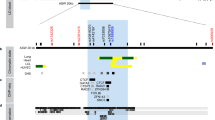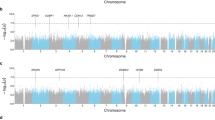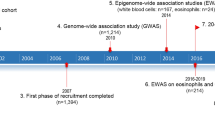Abstract
The human chromosomal 5q31–33 region has been implicated as a susceptibility locus for several immune-mediated diseases including asthma in several populations. Recently, the extraneuronal GABAergic system has been implicated as a new link to airway obstruction in asthma. In addition, the SLC6A7 gene, which is positioned at 5q31–32 and encodes the transporter for an excitatory neurotransmitter of L-proline, has never been studied for its association with asthma. In this study, resequencing of all exon, promoter region (2 kb), and exon–intron boundary regions in the SLC6A7 gene found a total of 33 single nucleotide polymorphisms (SNPs) in 24 Korean asthmatic patients. After the initial SNP survey, a total of 17 common SNPs with minor allele frequency (MAF) over 10% were genotyped in 498 asthmatic patients and 303 normal controls. Logistic analyses revealed significant associations between genetic variants of the SLC6A7 gene and asthma (P-value up to 6.0 × 10−4; Pcorr value up to 0.009). In further regression analyses, minor alleles of intronic +11431T>C, +12213C>T and +12927A>G in linkage disequilibrium block 2 and +20113T>C in 3′UTR significantly increased the bronchodilator response in asthmatics (P-value of recessive model up to 0.008; which are not significant after multiple correction). Therefore, our findings suggest that SLC6A7 could be a susceptible gene for asthma.
Similar content being viewed by others
Log in or create a free account to read this content
Gain free access to this article, as well as selected content from this journal and more on nature.com
or
References
Kay, A. B., Phipps, S. & Robinson, D. S. A role for eosinophils in airway remodelling in asthma. Trends Immunol. 25, 477–482 (2004).
Sengler, C., Lau, S., Wahn, U. & Nickel, R. Interactions between genes and environmental factors in asthma and atopy: new developments. Respir. Res. 3, 7 (2002).
Van Eerdewegh, P., Little, R. D., Dupuis, J., Del Mastro, R. G., Falls, K., Simon, J. et al. Association of the ADAM33 gene with asthma and bronchial hyperresponsiveness. Nature 418, 426–430 (2002).
Moffatt, M. F., Kabesch, M., Liang, L., Dixon, A. L., Strachan, D., Heath, S. et al. Genetic variants regulating ORMDL3 expression contribute to the risk of childhood asthma. Nature 448, 470–473 (2007).
Himes, B. E., Hunninghake, G. M., Baurley, J. W., Rafaels, N. M., Sleiman, P., Strachan, D. P. et al. Genome-wide association analysis identifies PDE4D as an asthma-susceptibility gene. Am. J. Hum. Genet. 84, 581–593 (2009).
Postma, D. S., Bleecker, E. R., Amelung, P. J., Holroyd, K. J., Xu, J., Panhuysen, C. I. et al. Genetic susceptibility to asthma—bronchial hyperresponsiveness coinherited with a major gene for atopy. N. Engl. J. Med. 333, 894–900 (1995).
Rioux, J. D., Daly, M. J., Silverberg, M. S., Lindblad, K., Steinhart, H., Cohen, Z. et al. Genetic variation in the 5q31 cytokine gene cluster confers susceptibility to Crohn disease. Nat. Genet. 29, 223–228 (2001).
Ryu, H. J., Jung, H. Y., Park, J. S., Ryu, G. M., Heo, J. Y., Kim, J. J. et al. Gene-based single nucleotide polymorphisms and linkage disequilibrium patterns of 29 asthma candidate genes in the chromosome 5q31-33 region in Koreans. Int. Arch. Allergy Immunol. 139, 209–216 (2006).
Holloway, J. W., Lonjou, C., Beghe, B., Peng, Q., Gaunt, T. R., Gomes, I. et al. Linkage analysis of the 5q31-33 candidate region for asthma in 240 UK families. Genes Immun. 2, 20–24 (2001).
Black, S., Teixeira, A. S., Loh, A. X., Vinall, L., Holloway, J. W., Hardy, R. et al. Contribution of functional variation in the IL13 gene to allergy, hay fever and asthma in the NSHD longitudinal 1946 birth cohort. Allergy 64, 1172–1178 (2009).
Early, S. B., Huyett, P., Brown-Steinke, K., Borish, L. & Steinke, J. W. Functional analysis of -351 interleukin-9 promoter polymorphism reveals an activator controlled by NF-kappaB. Genes Immun. 10, 341–349 (2009).
Shimokawa, N., Nishiyama, C., Hirota, T., Tamari, M., Hara, M., Ikeda, S. et al. Functional analysis of a polymorphism in the promoter region of the IL-12/23p40 gene. Clin. Exp. Allergy 39, 228–235 (2009).
Kim, Y., Park, C. S., Shin, H. D., Choi, J. W., Cheong, H. S., Park, B. L. et al. A promoter nucleotide variant of the dendritic cell-specific DCNP1 associates with serum IgE levels specific for dust mite allergens among the Korean asthmatics. Genes Immun. 8, 369–378 (2007).
Shafqat, S., Velaz-Faircloth, M., Henzi, V. A., Whitney, K. D., Yang-Feng, T. L., Seldin, M. F. et al. Human brain-specific L-proline transporter: molecular cloning, functional expression, and chromosomal localization of the gene in human and mouse genomes. Mol. Pharmacol. 48, 219–229 (1995).
Velaz-Faircloth, M., Guadano-Ferraz, A., Henzi, V. A. & Fremeau, R. T. Jr. Mammalian brain-specific L-proline transporter. Neuronal localization of mRNA and enrichment of transporter protein in synaptic plasma membranes. J. Biol. Chem. 270, 15755–15761 (1995).
Renick, S. E., Kleven, D. T., Chan, J., Stenius, K., Milner, T. A., Pickel, V. M. et al. The mammalian brain high-affinity L-proline transporter is enriched preferentially in synaptic vesicles in a subpopulation of excitatory nerve terminals in rat forebrain. J. Neurosci. 19, 21–33 (1999).
Warner, S. M. & Knight, D. A. Airway modeling and remodeling in the pathogenesis of asthma. Curr. Opin. Allergy Clin. Immunol. 8, 44–48 (2008).
Gosens, R., Zaagsma, J., Grootte Bromhaar, M., Nelemans, A. & Meurs, H. Acetylcholine: a novel regulator of airway smooth muscle remodelling? Eur. J. Pharmacol. 500, 193–201 (2004).
Xiang, Y. Y., Wang, S., Liu, M., Hirota, J. A., Li, J., Ju, W. et al. A GABAergic system in airway epithelium is essential for mucus overproduction in asthma. Nat. Med. 13, 862–867 (2007).
Lu, W. Y. & Inman, M. D. Gamma-aminobutyric acid nurtures allergic asthma. Clin. Exp. Allergy 39, 956–961 (2009).
Global Initiative for Asthma (GINA) Global strategy for asthma management and prevention. NHLBI/WHO Workshop Report (National Institutes of Health, National Heart, Lung, and Blood Institute, Bethesda, MD. NIH publication, 1995).
Pellegrino, R., Viegi, G., Brusasco, V., Crapo, R. O., Burgos, F., Casaburi, R. et al. Interpretative strategies for lung function tests. Eur. Respir. J. 26, 948–968 (2005).
Barrett, J. C., Fry, B., Maller, J. & Daly, M. J. Haploview: analysis and visualization of LD and haplotype maps. Bioinformatics 21, 263–265 (2005).
Hedrick, P. W. Gametic disequilibrium measures: proceed with caution. Genetics 117, 331–341 (1987).
Gordon, D. & Finch, S. J. Factors affecting statistical power in the detection of genetic association. J. Clin. Invest. 115, 1408–1418 (2005).
Ioannidis, J. P., Trikalinos, T. A. & Khoury, M. J. Implications of small effect sizes of individual genetic variants on the design and interpretation of genetic association studies of complex diseases. Am. J. Epidemiol. 164, 609–614 (2006).
Menashe, I., Rosenberg, P. S. & Chen, B. E. PGA: power calculator for case-control genetic association analyses. BMC Genet. 9, 36 (2008).
Kauppi, P., Lindblad-Toh, K., Sevon, P., Toivonen, H. T., Rioux, J. D., Villapakkam, A. et al. A second-generation association study of the 5q31 cytokine gene cluster and the interleukin-4 receptor in asthma. Genomics 77, 35–42 (2001).
Donfack, J., Schneider, D. H., Tan, Z., Kurz, T., Dubchak, I., Frazer, K. A. et al. Variation in conserved non-coding sequences on chromosome 5q and susceptibility to asthma and atopy. Respir. Res. 6, 145 (2005).
Koppelman, G. H., Meyers, D. A., Howard, T. D., Zheng, S. L., Hawkins, G. A., Ampleford, E. J. et al. Identification of PCDH1 as a novel susceptibility gene for bronchial hyperresponsiveness. Am. J. Respir. Crit. Care Med. 180, 929–935 (2009).
Pisi, G., Olivieri, D. & Chetta, A. The airway neurogenic inflammation: clinical and pharmacological implications. Inflamm. Allergy Drug Targets 8, 176–181 (2009).
Barnes, P. J. Neuropeptides and asthma. Am. Rev. Respir. Dis. 143, S28–S32 (1991).
Barnes, P. J. Neurogenic inflammation in the airways. Respir. Physiol. 125, 145–154 (2001).
Dicpinigaitis, P. V., Spungen, A. M., Bauman, W. A., Absgarten, A. & Almenoff, P. L. Inhibition of bronchial hyperresponsiveness by the GABA-agonist baclofen. Chest 106, 758–761 (1994).
Felix, D. & Kunzle, H. The role of proline in nervous transmission. Adv. Biochem. Psychopharmacol. 15, 165–173 (1976).
Shen, Z. J., Esnault, S. & Malter, J. S. The peptidyl-prolyl isomerase Pin1 regulates the stability of granulocyte-macrophage colony-stimulating factor mRNA in activated eosinophils. Nat. Immunol. 6, 1280–1287 (2005).
Marsh, D. G., Neely, J. D., Breazeale, D. R., Ghosh, B., Freidhoff, L. R., Ehrlich-Kautzky, E. et al. Linkage analysis of IL4 and other chromosome 5q31.1 markers and total serum immunoglobulin E concentrations. Science 264, 1152–1156 (1994).
Lipworth, B. J., Hall, I. P., Tan, S., Aziz, I. & Coutie, W. Effects of genetic polymorphism on ex vivo and in vivo function of beta2-adrenoceptors in asthmatic patients. Chest 115, 324–328 (1999).
Ober, C. & Hoffjan, S. Asthma genetics 2006: the long and winding road to gene discovery. Genes Immun. 7, 95–100 (2006).
Yokouchi, Y., Nukaga, Y., Shibasaki, M., Noguchi, E., Kimura, K., Ito, S. et al. Significant evidence for linkage of mite-sensitive childhood asthma to chromosome 5q31-q33 near the interleukin 12 B locus by a genome-wide search in Japanese families. Genomics 66, 152–160 (2000).
Wu, Q. W., Cai, P. C., Wang, L., Li, Y. R., Kong, L. L. & Hu, L. H. Family-based association study of Tim-1 and Tim-3 gene polymorphisms with childhood asthma in Chinese trios. Int. Arch. Allergy Immunol. 150, 252–260 (2009).
Wu, Q., Hu, L., Cai, P., Li, Y., Chen, F. & Kong, L. Association analysis of TIM-1 -232G>A and 5383_5397 insertion/deletion polymorphisms with childhood asthma and total serum immunoglobulin E levels in middle China. J. Investig. Allergol. Clin. Immunol. 19, 146–153 (2009).
Meyers, J. H., Chakravarti, S., Schlesinger, D., Illes, Z., Waldner, H., Umetsu, S. E. et al. TIM-4 is the ligand for TIM-1, and the TIM-1-TIM-4 interaction regulates T cell proliferation. Nat. Immunol. 6, 455–464 (2005).
Renauld, J. C. New insights into the role of cytokines in asthma. J. Clin. Pathol. 54, 577–589 (2001).
Taylor, D. R. & Kennedy, M. A. Genetic variation of the beta(2)-adrenoceptor: its functional and clinical importance in bronchial asthma. Am. J. Pharmacogenomics 1, 165–174 (2001).
Corvol, H., De Giacomo, A., Eng, C., Seibold, M., Ziv, E., Chapela, R. et al. Genetic ancestry modifies pharmacogenetic gene-gene interaction for asthma. Pharmacogenet. Genomics 19, 489–496 (2009).
Plotkin, J. B., Robins, H. & Levine, A. J. Tissue-specific codon usage and the expression of human genes. Proc. Natl. Acad. Sci. USA 101, 12588–12591 (2004).
Dittmar, K. A., Goodenbour, J. M. & Pan, T. Tissue-specific differences in human transfer RNA expression. PLoS Genet. 2, e221 (2006).
Kimchi-Sarfaty, C., Oh, J. M., Kim, I. W., Sauna, Z. E., Calcagno, A. M., Ambudkar, S. V. et al. A ‘silent’ polymorphism in the MDR1 gene changes substrate specificity. Science 315, 525–528 (2007).
Gupta, S. K., Majumdar, S., Bhattacharya, T. K. & Ghosh, T. C. Studies on the relationships between the synonymous codon usage and protein secondary structural units. Biochem. Biophys. Res. Commun. 269, 692–696 (2000).
Stamm, S., Riethoven, J. J., Le Texier, V., Gopalakrishnan, C., Kumanduri, V., Tang, Y. et al. ASD: a bioinformatics resource on alternative splicing. Nucleic. Acids Res. 34, D46–D55 (2006).
Ronchetti, R., Rennerova, Z., Barreto, M. & Villa, M. P. The prevalence of atopy in asthmatic children correlates strictly with the prevalence of atopy among nonasthmatic children. Int. Arch. Allergy Immunol. 142, 79–85 (2007).
Ronchetti, R., Jesenak, M., Rennerova, Z., Barreto, M., Ronchetti, F. & Villa, M. P. Relationship between atopic asthma and the population prevalence rates for asthma or atopy in children: atopic and nonatopic asthma in epidemiology. Allergy Asthma Proc. 30, 55–63 (2009).
Contopoulos-Ioannidis, D. G., Kouri, I. N. & Ioannidis, J. P. Genetic predisposition to asthma and atopy. Respiration 74, 8–12 (2007).
Acknowledgements
This work was supported by a grant from the Korea Health 21 R&D Project (A010249) and by Grant number M1-0302-00-0073 from the Korea Science and Engineering Foundation (KOSEF), funded by the Korean government (Ministry of Education, Science and Technology [MEST]) (No. 2009-0080157), and a Priority Research Centers Program through the National Research Foundation of Korea (NRF) funded by the Ministry of Education, Science and Technology (2009-0093822). The DNA samples were generously provided by the Soonchunhyang University, Bucheon Hospital Biobank, a member of the National Biobank of Korea, supported by the Ministry of Health, Welfare and Family Affairs, Republic of Korea.
Author information
Authors and Affiliations
Corresponding authors
Additional information
Supplementary Information accompanies the paper on Journal of Human Genetics website
Rights and permissions
About this article
Cite this article
Kim, JH., Cheong, H., Park, BL. et al. A new association between polymorphisms of the SLC6A7 gene in the chromosome 5q31–32 region and asthma. J Hum Genet 55, 358–365 (2010). https://doi.org/10.1038/jhg.2010.34
Received:
Revised:
Accepted:
Published:
Issue date:
DOI: https://doi.org/10.1038/jhg.2010.34
Keywords
This article is cited by
-
Aberrant glial activation and synaptic defects in CaMKIIα-iCre and nestin-Cre transgenic mouse models
Scientific Reports (2022)
-
Pathogen-associated selection on innate immunity genes (TLR4, TLR7) in a neotropical rodent in landscapes differing in anthropogenic disturbance
Heredity (2020)
-
Large deletions encompassing the TCOF1 and CAMK2A genes are responsible for Treacher Collins syndrome with intellectual disability
European Journal of Human Genetics (2014)



